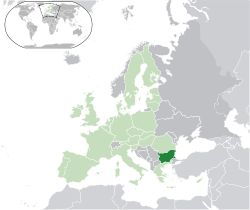Bulgaria
Background:
With a territory of 110,994 square kilometers, Bulgaria ranks as the 16th-largest country in Europe. Several mountainous areas define the landscape, most notably the Stara Planina (Balkan) and Rodopi mountain ranges, as well as the Rila range, which includes the highest peak in the Balkan region, Musala. In contrast, the Danubian plain in the north and the Upper Thracian Plain in the south represent Bulgaria's lowest and most fertile regions. The 378-kilometer Black Sea coastline covers the entire eastern bound of the country. Bulgaria's capital city and largest settlement is Sofia, with a permanent population of 1,405,000 people. The country joined NATO in 2004 and EU in 2007.
Area:
-
Total 110,993.6 km2 (104th)= 42,823 sq mi
- Water (%) 0.3
Population:
- 2009 estimate 7,563,710[3] (95th)
- 2001 census 7,932,984
- Density 68.5/km2 (124th) = 168.2/sq mi
Climate:
Bulgaria overall has a temperate climate, with cold winters and hot summers. The barrier effect of the Balkan Mountains has some influence on climate throughout the country - northern Bulgaria experiences lower temperatures and receives more rain than the southern lowlands.
The above characteristics have been provided by Wikipedia. View these pages for more information on Bulgaria.


